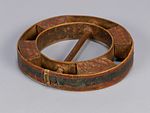hawidzis (Rattle)
About this object
History of use
Circular rattle used to accompany the halait dance (healer’s dance). Similar circular rattles are also represented in miniature on Haida carvings depicting shamans, and may have once been a form common to other nations of the northern Northwest Coast.
Narrative
This rattle may be one of a pair, as it is very similar to a rattle (VII-C-1116) in the collection of the Canadian Museum of History (CMH). A pair of circular rattles of this type was owned by Chief Simadiiks (Semedik), of Gitwangak. In 1924, the artist W. Langdon Kihn painted a portrait titled "Portrait of Sem-Medeeks of Gitinanga" (image available online, Wellcome Collection), in which Chief Semedik is shown holding a rattle similar to MOA rattle A2588. Kihn spent the summer of 1924 painting in Gitwangak, on the banks of the Skeena River, having been invited by ethnologist Marius Barbeau. One of the rattles was collected by Marius Barbeau, in 1924, for the Museum of Man (VII-C-1116). Barbeau documented it as one of a pair of circular rattles (“hasɛ’x and hawidzis is the name of this type”) used “to accompany the halait dance” (healers’ dance), and noted that Kihn purchased its mate - the rattle depicted in his painting of Simadiiks. Rattle A2588 was acquired by Walter Koerner sometime before the early 1970s. It was initially classified as Haida, likely because such circular rattles (sometimes called shaman or healers' rattles), were also used by the Haida (-e.g., Am1954,05.928, British Museum, from the Wellcome Coll.), along with other northern coastal peoples.
Cultural context
ceremonial
Physical description
Date Made
Before 1920
Date Acquired
8 Apr 1976
How Acquired
Donated
Credit Line
The Walter and Marianne Koerner Collection of First Nations ArtMore...
Measurements
Overall: 3 cm x 17.3 cm
Object Number
A2588
